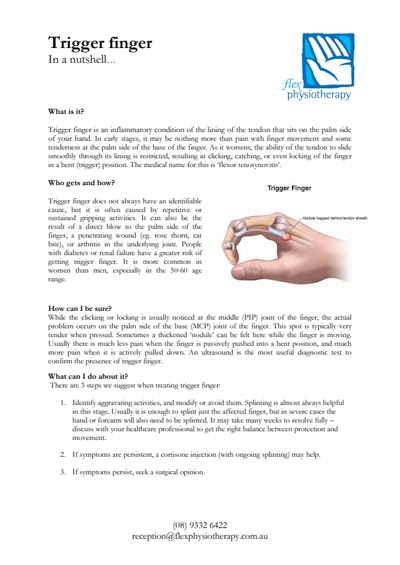Trigger finger
What is it?
Trigger finger is an inflammatory condition of the lining of the tendon that sits on the palm side of your hand. In early stages, it may be nothing more than pain with finger movement and some tenderness at the palm side of the base of the finger. As it worsens, the ability of the tendon to slide smoothly through its lining is restricted, resulting in clicking, catching, or even locking of the finger in a bent (trigger) position. The medical name for this is 'flexor tenosynovitis'.
Who gets and how?
Trigger finger does not always have an identifiable cause, but it is often caused by repetitive or sustained gripping activities. It can also be the result of a direct blow to the palm side of the finger, a penetrating wound (eg. rose thorn, cat bite), or arthritis in the underlying joint. People with diabetes or renal failure have a greater risk of getting trigger finger. It is more common in women than men, especially in the 50-60 age range.
How can I be sure?
While the clicking or locking is usually noticed at the middle (PIP) joint of the finger, the actual problem occurs on the palm side of the base (MCP) joint of the finger. This spot is typically very tender when pressed. Sometimes a thickened 'nodule' can be felt here while the finger is moving. Usually there is much less pain when the finger is passively pushed into a bent position, and much more pain when it is actively pulled down. An ultrasound is the most useful diagnostic test to confirm the presence of trigger finger.
What can I do about it?
There are 3 steps we suggest when treating trigger finger:
- Identify aggravating activities, and modify or avoid them. Splinting is almost always helpful in this stage. Usually it is enough to splint just the affected finger, but in severe cases the hand or forearm will also need to be splinted. It may take many weeks to resolve fully – discuss with your healthcare professional to get the right balance between protection and movement.
- If symptoms are persistent, a cortisone injection (with ongoing splinting) may help.
- If symptoms persist, seek a surgical opinion.
